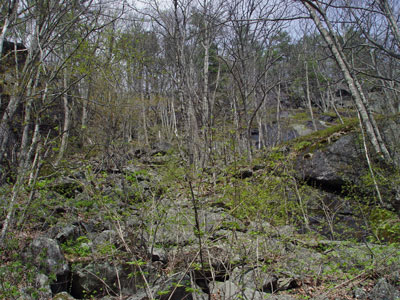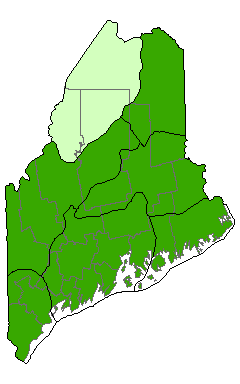DACF Home → Bureaus & Programs → Maine Natural Areas Program → Communities, Plants, and Animals → Natural Community Fact Sheets → Birch - Oak Talus Woodland
Printer Friendly Fact Sheet - 950 KB pdf (Get a free copy of Adobe Acrobat Reader)
Birch - Oak Rocky Woodland
Scientific Name: Birch - Oak Talus Woodland; State Rank: S3

- Community Description
- Soil and Site Characteristics
- Diagnostics
- Similar Types
- Conservation, Wildlife and Management Considerations
- Distribution
- Characteristic Plants
- Associated Rare Plants
- Associated Rare Animals
- Examples on Conservation Lands You Can Visit
Community Description: These community types are partial canopy deciduous woodlands or patches of woodland among talus areas. Overall canopy closure may be <25% when the open areas are included. Paper birch, red oak, and/or yellow birch are dominant. Sugar maple, if present, is not abundant. Marginal wood-fern, rock polypody, and poison ivy are characteristic of the herb layer, which is best developed in open patches. Vegetation is generally very patchy, developing in pockets among the rocks. Back to top.
Soil and Site Characteristics: Sites typically occur on dry, acidic talus substrates with various aspects. Documented elevations are from nearly sea level to about 1500’. Back to top.
Diagnostics: Sites occur on talus substrate; conifer cover can be one-fourth of the canopy, ironwood is absent and birches are common. Back to top.
Similar Types: Oak - Ash Woodlands are similar. They may have a high cover of red oak, but also include ironwood and sometimes sugar maple. Birches are less common, and the herbaceous flora includes rich site indicators that are absent from this type. Other community types dominated by red oak occur on thin soil over bedrock or on deeper soils. Oak - Pine Woodlands, the most similar, typically include bracken fern and lowbush blueberry, which are rarely (or only sparsely) found in talus woodlands. Back to top.
Conservation, Wildlife and Management Considerations: Talus woodlands receive little human use because of their inaccessibility and low timber value; however, areas at the base of talus slopes that receive water and nutrients from above sometimes have enough large trees to make logging economical. Conservation of these sites should include the range of talus forest cover, from the base of the slope on up, with a buffer of adjacent forest cover.
South facing occurrences of this type in the southern part of the state may have provided historical habitat for the timber rattlesnake, which is believed to have been extirpated from Maine. Back to top.
Distribution: Not well documented. Extends westward from Maine, and possibly in other directions. Landscape Pattern: Small Patch. Back to top.


Characteristic Plants: These plants are frequently found in this community type. Those with an asterisk are often diagnostic of this community.
- Canopy
- Big-toothed aspen
- Blue birch*
- Paper birch*
- Red maple
- Red oak*
- Striped maple
- Yellow birch*
- Sapling/shrub
- Mountain maple*
- Striped maple*
- Yellow birch*
- Dwarf Shrub
- Lowbush blueberry
- Poison-ivy
- Herb
- Big-leaved aster
- Common hairgrass
- Marginal woodfern
- Rock polypody
- Wild sarsaparilla
- Bryoid
- Dicranum moss
- Large hair-cap moss
- Pincushion moss
There are no documented rare animals associated with this natural community.
Examples on Conservation Lands You Can Visit
| Example | County |
|---|---|
| Acadia National Park | Hancock Co. |
| Caribou Mountain, Donnell Pond Public Lands | Hancock Co. |
| Horse Mountain, Baxter State Park | Penobscot Co. |
| Little Kineo Mountain Public Lands | Piscataquis Co. |